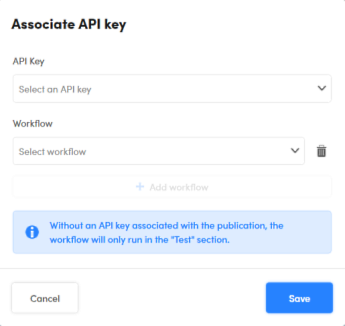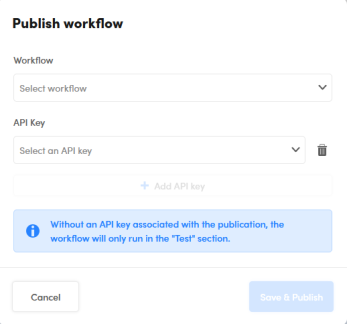Runtime view
The Runtime view of the NL Flow dashboard shows information about the NL flow runtime and allows managing API keys. API keys are linked to published workflows as an authorization mechanism: only calls to the NL Flow API containing a valid API key can work.
It also allows publishing and opening workflows.

Runtime information
The runtime is the virtual computer where published workflows are hosted and run.
NL Flow runtime information is displayed in the Runtime Core panel.

- CPU load shows allocated CPUs and the overall CPU capacity of the runtime. CPUs are expressed in thousandths of one CPU, so for example, 7000 m corresponds to 7 full CPUs, while 4500 m corresponds to 4 CPUs "and an half". The m suffix stands for "milli".
- Memory load shows allocated and maximum memory expressed in mibibytes or gibibytes.
- Workflows limit show the current and the maximum number of published workflows.
- Javascript blocks limit shows the current and the maximum number of JavaScript operators used in all published workflows.
The panel also shows the number of API keys and the number of workflows linked to those keys.
Workflows without API key
Above the list of API keys, the list of workflows not linked to an API key is shown. To show and hide the list use the toggle button to the left of the Without API key label.
Use the Show card view  and Show table view
and Show table view  buttons on the area's toolbar to switch between table and cards visualizations for the list of workflows.
buttons on the area's toolbar to switch between table and cards visualizations for the list of workflows.
The information that is displayed inside the list is described in the article about the Workflows view. In table view this information is:
- Number of blocks
- Initials of the user that made the last edit
- Last edit time
- Publish state (the colored dot)
Browse API keys
For each API key, the number of linked workflows, the creation date and the name of the creator are displayed.
To show and hide the list of workflows linked to an API key use the toggle button to the left of key name. The information for each workflow is the same as in the list of workflows without a key (see above). Also the same visualzations—cards or table—apply.
Create an API key
To create a new API key select Add new API key at the bottom left of the page.
A wizard starts asking for the name and an identifying color for the key. Specify this information and select Create.
The generated key is shown in a dialog.
Warning
The key is only visible at this time. It is therefore necessary to copy the key before closing the dialog.
Select Copy to clipboard then paste the value in a safe place, such as a password manager.
Regenerate a key
API keys do not expire, but it's a recommended security practice not to use them for too long.
To regenerate a key, select it and choose Regenerate  on the area's toolbar.
on the area's toolbar.
Warning
Key regeneration immediately invalidates the old key with the same name, so any NL Flow API client application using the old key value will stop working.
Link a key to workflows
To link a key to one or more workflows:
-
Select any key from the list then select Link workflows
 on the area's toolbar. The Associate API key dialog appears.
on the area's toolbar. The Associate API key dialog appears.
-
Select the key from the API Key drop-down list.
- Select the workflow from the Workflow drop-down list.
If you want to link the same key to more workflows:
- Select Add workflow: a new drop-down list appears.
- Select the workflow from the new drop-down list. Repeat from step 1 to link more workflows.
To remove a workflow from the list, select the trash can button  on the right of the workflow item.
on the right of the workflow item.
Info
It's not needed that the workflow is published to link an API key to it.
You can also link a key to a workflow when you publish the workflow.
Delete a key
To delete an API key, select it from the list and choose Delete  on the area's toolbar.
on the area's toolbar.
Edit a key
To change the name or the identifying color of an API key, select it from the list thenselect Edit  on the area's toolbar.
on the area's toolbar.
Open a workflow
To open a workflow that is listed under an API key or Without API key:
-
Table visualization:
- Double click the workflow row
Or:
- Select the workflow name
-
Cards visualization:
- Double-click the card
Or:
- Select the workflow name
The workflow is opened in its workspace where the default tab is Editor.
Publish a workflow
To publish a workflow and link it to one or more API keys:
-
Select Publish workflow on the bottom left of the page
Or:
Select any API key then select Publish
 on the area's toolbar.
on the area's toolbar.The Publish workflow dialog appears.

-
Select the workflow from the Workflow drop-down list.
-
Select a key from the API Key drop-down list.
If you want to link more API keys to the same workflow:- Select Add API key: a new drop-down list appears.
- Select the key from the new drop-down list. Repeat from the previous step to link more keys.
To remove an API key from the list, select the trash can button
 on the right of the key item.
on the right of the key item. -
Select Save & Publish to confirm the operation.
To publish a workflow without linking it to an API key, do as above omitting step 3.
Published workflows without an API key can only be tested from the NL Flow application, they cannot be used via the NL Flow API.
Switch to another view
To switch to another view of the dashboard, use the common toolbar described in the introduction to the dashboard.